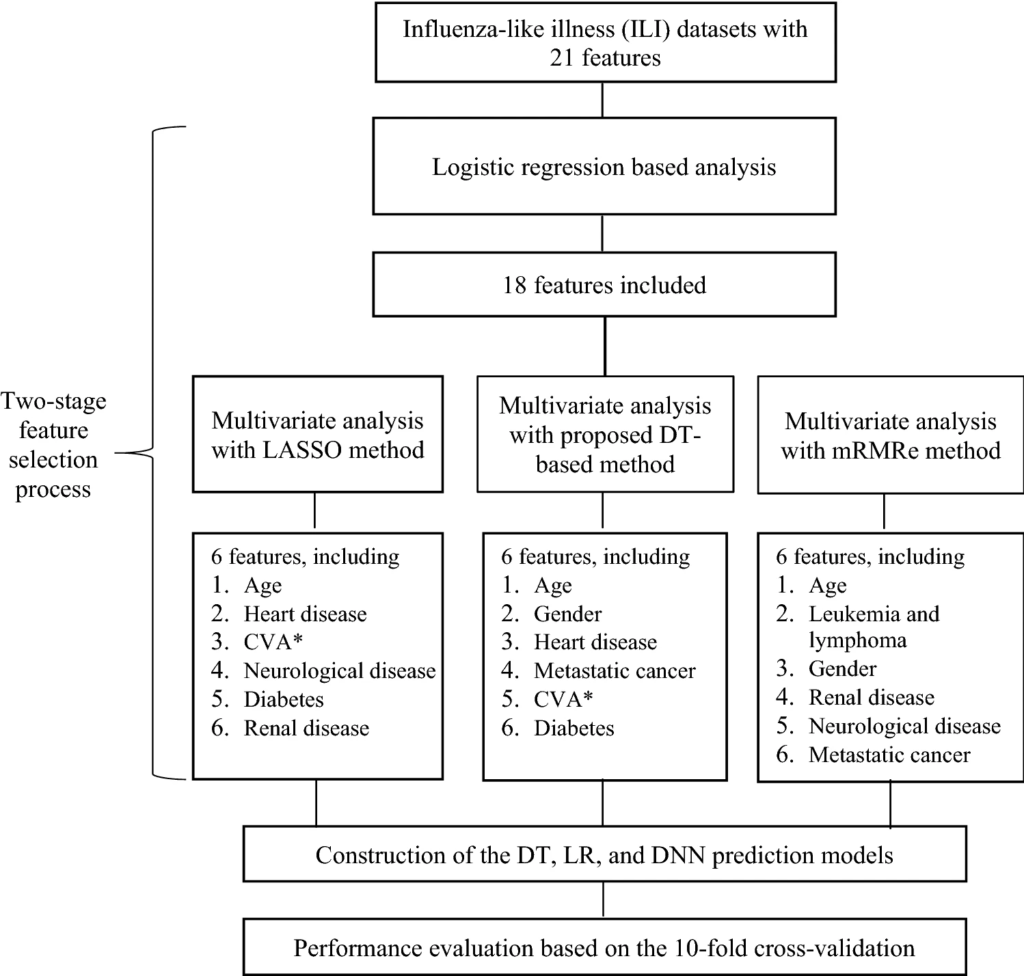研究主題:機器學習於新興傳染病領域
撰寫:學生王馨
新興傳染病 (EID),包括嚴重急性呼吸綜合徵 (SARS) (2003)、H1N1流感病毒 (2009)、中東呼吸綜合徵冠狀病毒 (MERS-CoV) (2012) 和2019年冠狀病毒病 (COVID -19) 大流行,近幾十年出現並引發了全球公共衛生危機。如果沒有現有的保護性免疫,EID可能會迅速傳播並在很短的時間內造成大量人員傷亡。當醫療機構因大量患者而不堪重負時,識別具有疾病進展風險的病例以優化醫療資源配置是相當必要的。
歐陽彥正教授及其團隊致力開發機器學習技術,以從預防醫學方面應對這一項挑戰。在該團隊的研究中,他們僅將年齡、性別和合併症作為特徵來構建基於ML的預測模型,以識別感染前有患嚴重疾病風險的人群。該研究所使用的樣本主要是基於83,227例的流感樣住院患者,並分析了19種合併症以及年齡和性別對嚴重疾病或死亡風險的風險影響。為了解決問題,此團隊共開發出三種模型,分別為DT模型、最先進的DNN模型,以及傳統的基於邏輯回歸的預測模型。
歐陽教授及其團隊對如何利用機器學習算法對住院流感樣疾病患者 (ILI) 的重症或死亡風險進行分層進行了全面分析。這項研究有三個主要發現。首先,本研究中研究的三種不同類型的預測模型,即DNN模型、LR模型和提出的基於DT的模型,在預測住院後嚴重ILI方面具有可比的性能。其次,DT模型的樹形結構明確說明了預測是如何進行的,並為臨床醫生製定有效的ILI患者風險分層策略提供了有價值的指導。第三,臨床醫生可以使用具有適當敏感性的DT模型來應對EID不同流行階段的醫療資源可用性和公共衛生需求。這些ML模型在衛生政策制定者需要識別高風險人群並制定相應的優先疫苗接種策略時,可以發揮重大的作用。並且,一線醫生可以結合所提出的預測模型來對沒有實驗室測試的患者進行分類,以便以最小的風險讓患者出院。歐陽教授及其團隊的研究所開發的機器學習技術,對於衛生政策制定者和醫療人員在EID爆發期間的應對都將有相當大的貢獻。
Emerging infectious diseases (EIDs), including the severe acute respiratory syndrome (SARS) (2003), H1N1 influenza virus (2009), Middle East respiratory syndrome coronavirus (MERS-CoV) (2012), and coronavirus disease 2019 (COVID-19) pandemic, emerged and raised global public health crises in recent decades. Without existing protective immunity, an EID may spread rapidly and cause mass casualties in a very short time. It is imperative to identify cases with risk of disease progression for the optimized allocation of medical resources in case medical facilities are overwhelmed with a flood of patients.
Prof. Yen-Jen Oyang and his team are committed to developing machine learning techniques to address this challenge in preventive medicine. In their research, they incorporated only age, sex, and comorbidities as features to build the ML based prediction models for identifying the population at risk of severe diseases before infection. The study has been based on 83,227 hospital admissions with influenza-like illness and analysed the risk effects of 19 comorbidities along with age and gender for severe illness or mortality risk. To solve the problem, the team have developed three types of prediction models, namely, the DT models, the state-of-the-art DNN models, as well as the conventional logistic regression-based prediction models.
In the research, Prof. Oyang and his team have conducted a comprehensive analysis on how to exploit machine learning algorithms to stratify the risk of severe illness or death among hospitalized ILI patients. There were three major findings in this study. Firstly, the three different types of prediction models investigated in this study, namely the DNN models, the LR models, and the proposed DT based models, delivered comparable performance in predicting severe ILI after hospitalization. Secondly, the tree structures of the DT models explicitly illustrated how predictions were made and provide valuable guidelines for clinicians to develop effective strategies for risk stratification of ILI patients. Thirdly, the clinicians can employ the DT models with an appropriate sensitivity level to cope with the availability of medical resources and public health needs in different epidemic stages of an EID disaster. The proposed ML models are of significant merit when health policymakers need to identify high risk populations and then develop a prioritized vaccination strategy accordingly. Moreover, frontline physicians could incorporate the proposed prediction models to triage patients without laboratory tests, in order to discharge patients with minimal risk. The machine learning techniques developed by Prof. Oyang and his team’s research institute will have considerable contributions to the response of both health policymakers and medical personnel during the EID outbreak.

